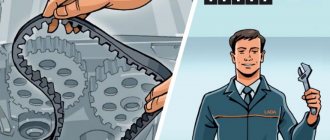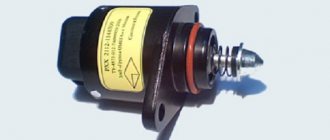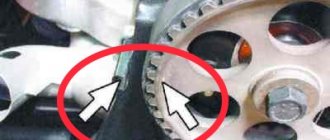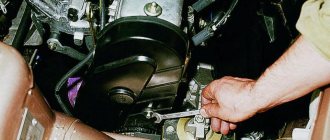Very often, after replacing the timing belt, owners of Renault and Lada Priora cars are faced with a problem: a rhythmic noise is heard in the timing belt area. In today's article we will figure out where this noise can come from, where to look for the cause of the problem and how to fix it without resorting to the help of specialists.
The GDS system stands out for its extremely complex structure. In order for it to periodically function in the correct mode, it is necessary to timely check and replace certain parts
After replacing the belt and pulley, the timing belt began to make a strange noise - what to do?
A few days ago I noticed that when warming up an engine that had cooled overnight, a rhythmic noise was heard in the timing belt area. I didn’t attach much importance to this, since I was guilty of a roller that I didn’t change when replacing the timing belt (a break on the highway). Yesterday I finally changed it, the video fell apart in my hands after removal, but the sound not only did not disappear, but also intensified! (Again, when it’s cold). Can anyone tell me by the sound where to dig?
Most likely, the cause of the problem is an incorrect replacement of the timing belt and pulley, so I strongly recommend that you pay attention to the following:
- Friction against the timing cover from the inside
- Malfunction (looseness) of pulleys
- Pump play
- Incorrect installation and loose timing rollers
- Poor quality timing belt
Of course, these are not all possible malfunctions; you can find out more by watching this video.
How to get rid of whistling
If you hear a whistle, you should figure out what exactly is making the sound in the car. This could be a timing belt, an alternator belt, or rollers.
The most common cause of whistling is insufficient tension.
Tension check
First of all, check the belt tension.
Rule out that the alternator belt is whistling. Press on it, it should bend with a force of 10 kg by 10–15 millimeters.
After this, check the timing belt. It should rotate up to 90 degrees with a force of 1-2 kg. There are also special tensioners on sale, with the help of which the standard value is set.
GRS mechanism: operating principle
Let's start with the basics. The GDS system stands out for its extremely complex structure. In order for it to periodically function in the correct mode, it is necessary to timely check and replace certain parts.
To understand why the noise appeared, we need to delve into the structure of the system in more detail.
So, the GDS mechanism is a device that ensures the admission of the fuel mixture into the cylinders of the power plant, and is also responsible for the subsequent elimination of gases.
Considered to be an extremely complex internal combustion engine device, the GDS mechanism is responsible for the proper functioning of the engine valves. Moreover, everything must be carried out strictly within certain periods of time. The functioning of the system must be combined with the operation of other mechanisms.
How does the gas distribution mechanism work?
You can understand how the system works this way. For example, while driving, the driver presses the accelerator pedal to increase the speed of the car. As a result of this, the fuel mixture begins to flow into the internal combustion engine in larger quantities.
A motor is an even more complex device consisting of valves, actuators, shafts, etc. The task of the valves is to open and close in due time, and the drives are to create conditions for the automatic rotation of the shafts along the intended path and with a specific amplitude.
The camshaft pulley is located directly above the BC of the power plant. Valves and special pusher devices are also located here. Outside the cylinder head you can find the cam pulley disc.
Note. To prevent engine lubricant from being knocked out of the cover, the engineers provided a special oil seal.
It is important to understand that the new belt, which suddenly began to make noise, is put on the camshaft disc and receives its movement when the crankshaft flywheel rotates.
For good, or rather, correct belt tension, rollers are used. We must always monitor their normal functioning, just like the belt, they must be changed in a timely manner.
Consequences for the car
If you ignore the whistle and continue to drive with a worn timing belt or a skewed tensioner, you may encounter a drive failure. This will create a desynchronization in the movement of the piston system and the cylinder head valve mechanism. They will begin to converge and disperse chaotically. The internal combustion engine will definitely stall and it will be impossible to start it. You will have to tow the car to the service station, calling a friend on wheels or a taxi.
Bend valves
But that is not all. In some engine models, this means that the pistons and valves will literally meet. Since the connecting rods are more powerful, the valve stems bend during a collision. The nickels themselves may break off and parts of them will fall into the cylinders. For repairs, you will need to completely remove the cylinder head, oil pan, crankshaft, connecting rods and check each cylinder for metal debris. Then buy new valves and restore the broken seats in the block head. To do this, they are welded with argon, then sharpened and ground. Therefore, you should not ignore the whistle and it is better to immediately contact the service.
Changed Timing Noise
I changed the timing belt on an excellent car, Toyota Gaia. I began to notice that there was some noise in the timing belt area. On one of my cars, such a noise was caused by a tightened belt, here it seems to tighten itself. Or am I wrong. What should I show to the specially trained person who changed my belt. The noise feels like everything is really tense or touching something. Your opinion, gentlemen. What should I show to the master?, and I believed him so much!!!, I called him, he said come, we’ll see. I’m going tomorrow morning.
Everything for the oligarchs..www.mammoth.ru
1. Is the belt original? 2. An error in setting the belt by 1-2 teeth gives the sound of a diesel engine at idle.
...the dust of many cities lies on my shoes...
The belt is original, at least that’s what was said, 1000 rubles in my opinion.
I left the car and went on a minibus and ride the metro. I don’t know what XX is. At 2000 tension you can hear the most. It seems to decrease as it warms up, but maybe I’m getting used to it. The dynamics and starting remained the same. Although it seemed like there was a smell of gasoline when you reset it. I haven’t caught it yet. Maybe from the neighbors on the road. Water pump? but why immediately after replacement? Mator 3 p. So, retightening is impossible on this model? There seems to be a tension roller there. Master, the guy seems normal, I wouldn’t want to be disappointed.Everything for the oligarchs..www.mammoth.ru
Maybe the pump, if so, it will leak very soon (if it hasn’t already). Or maybe the strap was too tight. For example, on a generator. Or maybe errors during assembly. In short, you need to watch and listen with your ears under the hood ;-). If it drives normally, the belt is in place. If you miss the teeth, it either starts poorly or drives at random (dips, does not pull, etc.)
It's noisy for me too. At first they sinned on the pump. I changed the pump, the noise remained, loosening the belt does nothing. Someone here wrote a long time ago that there is some kind of rubber seal on the timing belt covers and it falls off, and the covers make a slightly rattling sound, but I never got around to looking at them. In short, I gave up and just drove like that.
I also have a rattling sound - probably the lid, because the sound is coming from under it
Hello everyone, on December 1, I replaced all the belts (including, of course, the timing belt), rollers, oil seals and some other gasket (it was included in the kit either for the pump or something else)... in short, I don’t know, I’m not an expert in this. And I changed it because... there were absolutely the same symptoms as the “TUSK”, the noise at idle in the timing belt and generator area was slightly reminiscent of the sound of a diesel engine, and some other extraneous noise, similar to the sound of a roller, around 2000 rpm the noise became stronger...... although it seemed It seemed to be warming up, and besides, the mileage is already 128,000 km, and as we know, it needs to be changed at 100,000 km, so I decided not to tempt fate. In short, after the replacement, the noise at idle went away completely, the engine runs almost silently and smoothly, but at about 2000 rpm it is still present, as if with some kind of strain. The dynamics have not changed. I think that the cause of the noise is not even in the timing belt, but in the rollers, maybe they wear out there and break.
In order to have no doubt that they installed exactly your belt and rollers and did everything correctly, it’s better not to be lazy and do it yourself, well, you’ll spend half a day, but you’ll be sure that you’ll always do it better yourself! (I know that some services still install viable used rollers, but your new ones will still be sold, the specifics of the business, gentlemen: ( ) PS: when re-tensioning, the belt does not make noise, but howls, especially as the speed increases.
Posted by
DrAspenPS: when tightening, the belt does not make noise, but howls, especially as the speed increases.
does this threaten anything, or will he pull himself up??? I have something like this, it howls a little
It is believed that the increased load on the pump and rollers stretches out over time, if during this time the pump does not cover (if it does, it was already going to be covered, but a little later), then it’s okay..
Message from
TuskThe belt is original, at least that’s what was said, 1000 rubles in my opinion. I left the car and went on a minibus and ride the metro. I don’t know what XX is. At 2000 tension you can hear the most. It seems to decrease as it warms up, but maybe I’m getting used to it. The dynamics and starting remained the same. Although it seemed like there was a smell of gasoline when you reset it. I haven’t caught it yet. Maybe from the neighbors on the road. Water pump? but why immediately after replacement? Mator 3 p. That is, retightening is impossible on this model? There seems to be a tension roller there.
Master, the guy seems normal, I wouldn’t want to be disappointed.
This is a pump. On our engines, the consumables are replaced along with the timing belt - 100% proven through bitter experience. Homemade people don’t want to bother again, it’s a hassle to pull it out and put it back in, so they limit themselves to replacing the belt and rollers; the money is also less work. By the way, it’s impossible to retighten the belt here. For me, in the summer they also changed the pumps in the same way.... A week later I bought a pump and went to others. The result is minus almost a hundred dollars. Plus, no noise, my soul is calm.
No, the pump runs for 200 thousand. There is no point in changing it, because it is Japanese, but you can easily install a Chinese one. Non-original belts are also noisy, because the teeth are not the exact size. Tomorrow we will figure it out, the master does not deny his guilt, that’s already a plus.
Everything for the oligarchs..www.mammoth.ru
Message from
TuskNo, the pump runs for 200 thousand. There is no point in changing it, because it is Japanese, but you can easily install a Chinese one. Non-original belts are also noisy, because the teeth are not the exact size. Tomorrow we will figure it out, the master does not deny his guilt, that’s already a plus.
After replacing the timing belt, the load on the pump bearing changes (increases), it is pretty worn out over its 100,000 km, hence the consequence. It’s not difficult to determine whether a pump is not a pump, just listen with the help of a device (like how doctors listen to the lungs). Everything seems to become clear there.
Posted by
Kip11After replacing the timing belt, the load on the pump bearing changes (increases), it is pretty worn out over its 100,000 km, hence the consequence. It’s not difficult to determine whether a pump is not a pump, just listen with the help of a device (like how doctors listen to the lungs). Everything seems to become clear there.
Yeah, that’s how they listened to me, but what’s the point, well, I bought a pump and changed it, and absolutely nothing has changed, some sound remains.
Posted by
Kip11This is a pump. On our engines, the consumables are replaced along with the timing belt - 100% proven through bitter experience. Homemade people don’t want to bother again, it’s a hassle to pull it out and put it back in, so they limit themselves to replacing the belt and rollers; the money is also less work. By the way, it’s impossible to retighten the belt here. For me, in the summer they also changed the pumps in the same way.... A week later I bought a pump and went to others. The result is minus almost a hundred dollars. Plus, no noise, my soul is calm.
It is VERY easy to tighten the belt; this happens when you help the tension spring with your hands before tightening the tension roller.
Posted by
Kip11After replacing the timing belt, the load on the pump bearing changes (increases), it is pretty worn out over its 100,000 km, hence the consequence. It’s not difficult to determine whether a pump is not a pump, just listen with the help of a device (like how doctors listen to the lungs). Everything seems to become clear there.
“device” stethoscope do you mean? Even though I’m a doctor, I can’t be 100 percent sure if it’s a pump... one can only guess..
and anyway .. Well, this is an S engine, its destiny is to make noise ..
There is also belt noise. It feels like it's touching the lid. As always, he scored.
Toyota RAV4, 2014, 4WD, 2.5, Prestige + KIA Sorento, 2013, 4WD, 2.4, Comfort
Posted by
DrAspenIt is VERY easy to tighten the belt; this happens when you help the tension spring with your hands before tightening the tension roller.
Such assistants must be killed.
Posted by
DrAspen“device” stethoscope do you mean? Even though I’m a doctor, I can’t be 100 percent sure if it’s a pump... one can only guess..
Why do you need to listen to all this? There are specialists who listen, we pay them money. Here it is important not to make a mistake in the master, otherwise his “diagnosis” will be costly...
Current time: 22:13. Time zone GMT +3.
Briefly about the causes and ways to eliminate them
If the belt begins to whistle when starting the car engine when cold, this is evidence that it is slipping. Inspection required. It is worth checking both the cleanliness and absence of cracks, and the tension level. A dirty, oily strap with a cracked working surface must be replaced. Dirt getting on the strap causes rapid wear not only of it, but also of the pulleys.
A clean product with a margin of service life is still suitable - just tighten it up if the system allows it. If this is not the case, then only installing a new one will help. The whistle appeared after a recent replacement - the belt was not tightened. Tightening does not help - either the pulleys are worn out, or the rubber product is not original. In special cases, a skewed tensioner is to blame for the squeak.
A skilled driver, who has devoted most of his life to driving his favorite car, can identify about a hundred different types of car breakdowns by ear. Each of the venerable car enthusiasts understands that every element disrupts the orderly functioning of a single mechanism as soon as it fails. The timing belt is no exception in this regard; if it malfunctions, it can howl and whistle. Why does it whistle, what reasons are associated with it, what can be done - the article will answer all these questions in detail.
Why does the timing belt make noise when cold?
Many car owners are faced with such a problem as a sharp whistle (squealing) from under the hood when the engine is running. It can appear both when the engine is “cold” and when the engine is fully warmed up, under different loads. Usually everyone starts to blame the occurrence of such a problem on the generator and its belt. At the same time, they do not pay attention to the second belt drive - the gas distribution mechanism.
But the appearance of a whistle in it is a more dangerous problem than in the drive belt of attachments. In general, it is not difficult to find out which drive has problems. It is enough to remove the alternator belt from the car and start the engine. A squeak that disappears or continues to sound will let you know where to look for the cause. If there is a squeal even with the belt removed, there is definitely a problem with the timing drive.
To more accurately identify what exactly caused it without any disassembly, you can use a technical phonendoscope. Using it, you can identify the area where the sound occurs, which will allow you to immediately determine which of the elements is faulty after sampling.
There are not so many main reasons for timing belt whistling:
Each of the reasons has its own characteristic features. For example, if you use a belt made of low-quality material that does not have sufficient elasticity, then in winter the rubber will “tan” after being parked in the cold. As a result of this, the drive element will be the cause of the “cold” whistle, which disappears after heating.
Step-by-step instructions for eliminating the defect
If noise appears when starting the engine after replacing an element, then there are several ways to eliminate the problem. Each of them will be considered in turn. If the quality of the strap is too low and it is already worn out, then it will need to be replaced; there are no other options. We will not consider this process, since it is individual for each car.
Use the search on our website to find step-by-step instructions for replacing an element for your car. You will find more information about this here. Next, we will look at options for eliminating the problem without removing the strap.
Lubricating the strap
Lubricating the element is one of the solutions to the problem if, after replacing the component, noise appears when starting the engine.
To lubricate the component, you need to purchase a special aerosol, which is sold in any store. In addition, universal WD-40 can be used for these purposes. Naturally, this solution is temporary, but it will only take a few minutes, after which the noise will no longer bother you.
Lubricated tension roller
- Take your aerosol and open the hood of your car.
- Remove the protective cover of the mechanism, which is secured with bolts, using the appropriate wrench.
- Be careful as you will need to start the car for it to work. This will make lubrication more effective. After starting the engine, you will need to aim to ensure that the liquid hits the inner parts of the strap, that is, the teeth. Lubricate the element for five to ten seconds so that the liquid is guaranteed to reach all the teeth.
- Stop the engine and replace the mechanism cover. Enjoy the results.
Potential Noise Contributors
So, many car owners who complain about timing belt noise have noted that the belt whistles more often when the engine is cold. In other words, when starting the engine.
How to check noise
Fortunately or unfortunately, this kind of problem is very common. Below are the most common causes of belt noise.
- Wear of gas distribution system components. It is not surprising that those elements that work in tandem with the timing belt, after wearing out, no longer cope with their tasks as before. For example, if the teeth of the shaft wheels are worn out.
- The belt itself has worn out, or rather, its teeth. In this case, it is already customary to talk not about the whistling of the belt after replacement, but about the noise of a worn-out product. Definitely, replacing the belt with a new element will help solve this problem if there are no other faults.
- Weak tension. If the HTZ roller is faulty or the tension is weak, the timing belt may whistle.
- The belt may also make noise if it gets grease or other compounds on it. For example, if a noise appears when the power plant is starting up when it is cold, this usually indicates a leak of coolant or lubrication of the internal combustion engine.
Brake fluid may also get on the belt for some reason. Also, aggressive liquid can get into the mechanism of any shaft disk.
- A whistle that appears immediately after replacement may also indicate poor quality of the product. Most likely, this belt was purchased for little money. Only replacing the belt with a better version will help, and nothing more.
Note. In some cases, the belt is lubricated, and then it no longer whistles, but only for a certain time. Then the “pandemonium” noisily begins again.
- Belt noise is also possible due to wear on the roller. If it has already served its service life and has not been replaced along with the belt, the whistle is its consequences. To eliminate the noise, you will have to replace the roller.
Replace or tighten
Some people don’t want to spend money on a kit, and they hope to get by with a timing belt tightening. If it is not worn out and was indeed tensioned incorrectly to begin with or has become loose later, this may solve the problem.
But pulling up will only help if the problem is not with the support roller. If the latter is skewed, the whistle may even intensify when the pressure becomes even greater.
In this case, tightening should only be used to prevent the timing belt from being too loose, to prevent it from jumping one or more teeth. After a temporary measure, you should visit a service station as soon as possible.
Why does the timing belt make noise (whistle) when hot?
Reader question: Good afternoon. Engine A20DTH (160 hp). The problem is this: after the engine warms up, at idle speed, an extraneous rustling noise is heard in the timing belt area. When the speed increases, the noise is not audible. The noise appears only at idle and when the engine is fully warmed up, i.e. if the engine temperature is less than 90 and the speed is idle, then there is no noise. Two weeks ago, the OD had the timing belt and rollers replaced under warranty (cyclical shuffling on a cold engine). When cold, it now works like a charm - without any extraneous sounds, but it rustles when it’s hot. What is the reason?
The GDS belt of the mechanism ensures synchronous rotation of the shafts, ensuring timely opening/closing of the valves. A worn belt will eventually break, but it can function in semi-working condition for some time. This can also explain the whistle or other noise coming from the GDS mechanism.
Below are common signs that your belt is wearing out.
- If the belt looks “shaggy” in appearance.
- Micro- or macrocracks are visible on the belt.
The main traces of “aging” of the timing belt can be seen on the reverse side of the product. This very jagged inner part bears traces of dirt or the result of poor road conditions.
In order to somehow increase preventive measures for caring for the belt, you should periodically monitor the condition of the protective casing. It is from here that, if the lid is not closed well, most of the dirt and dust gets in. It is important to understand that the integrity of the protective casing is the reliability of the belt and its long service life.
There are also indirect signs of belt wear. For example, one of these signs involves wear on the drive belt. In this case, knowing about the similarity of both resources and their approximately equal wear, the owner diagnoses the drive belt. If the latter looks clearly worn, then almost 90 percent of the belt can also be judged to be worn.
Product quality
Timing belt whining due to poor quality of the product is the third common reason. It is likely that the belt was purchased at a cheap price; the outer and inner surfaces of the product are of low quality. They have not been reinforced with metal rods well enough or the belt is old, lying in a warehouse.
Obviously, such a belt will function for some time. If you lubricate it, it will not make noise or whistle, but only for a certain time. One way or another, a replacement is needed.
Phases of the GRS mechanism
The phases of the gas distribution system are precisely what makes the car engine function simultaneously, without disruption. If these very phases go astray, then either the piston will not reach TDC at the right time, or the valve will lag behind, in a word, problems are inevitable.
Article on the topic: Do-it-yourself coilovers, making the suspension adjustable
The phases of the gas distribution system are always set according to the markings, due to which clear and synchronous operation of the motor is achieved.
Phases of the GRS mechanism
If you need to set the timing marks correctly, you will have to remove the belt. You will have to stock up on keys, screwdrivers and all those tools that will make the work easier. For example, a wrench for socket heads - this is convenient for attaching a nut almost anywhere.
Every expert will confirm that the GDS phases must be installed from the factory. But during active operation of the engine, repairs, etc., the phases shift, the car begins to pull poorly and the motor vibrates.
Algorithm for carrying out an operation to diagnose the correctness of marks:
- The top belt protection cover is removed.
- The gearbox switches to 4th.
- The car is pushed forward until the marks on the shaft coincide with the markings on the cover (bottom).
- Now you need to look under the hood.
- Here, find the clutch housing, remove the rubber lock from it, which blocks access to the hole through which the mark on the flywheel is clearly visible.
Note. This mark must necessarily align with the slot in the crankcase shield (it is triangular). If the marks do not match, it means that the phases of the gas distribution system are shifted. If they match, and the risk on the camshaft also matches, you don’t need to do anything.
conclusions
The generator belt tension roller is an important part, without which the correct functioning of the generator is impossible. At the slightest sign of severe wear, it is necessary to replace the generator belt tension roller. The roller can be found at a parts store. It is also necessary to monitor the remaining elements of the generator design. Replacing the tension roller of the alternator belt should not cause difficulties and can easily be carried out by the car owner himself without contacting a service station. Good luck and easy travels!
Source: auto-gl.ru
We will add only one thing on our own - do not neglect the advice of this article, and seek the service of replacing a spare part or repairing a car only at certified service stations or official dealers, because a malfunction of this part of the car can cause quite a lot of trouble on the road, and consequences afterwards, i.e. To. It's not just the alternator that turns the belt.
Noise 5: wind noise/whistle - the higher the speed, the more it blows in the car with the windows closed
The wind swirling around various parts of the car's body, such as the front grille, headlights, and bumpers, creates natural noise as the speed increases. Typically, such noises are not heard inside the car due to sound insulation. By the way, usually when designing a car and testing it in a wind tunnel, engineers design the body in such a way that even at high speed no wild noise is generated.
If your car makes excessive wind noise at speed, it may be due to the installation of additional accessories such as a trunk, spotlights, wing, spoiler or side deflectors on the windows. It is also quite possible that strong noise at speed is associated with loss of body geometry after poor-quality restoration after an accident.
Solving this problem again involves trial and error. For example, if you suspect the noise is coming from the roof rack, remove it and test the car at speed without it.
Noise 4: rumbling sound from under the hood - bearing wear
If you hear a low rumbling sound coming from under the hood, it is possible that the sound is coming from a worn bearing. To accurately determine the location of the noise source under the hood, careful diagnostics at the service center is required. The fact is that the noise can come from the generator, from the power steering pump, the air conditioning compressor, and even from the drive shafts.
If you hear a similar sound from under the hood, do not delay a trip to a technical auto center, since ignoring the noise from under the hood can lead to serious damage, including to the engine, the repair of which can sometimes cost more than the cost of the car itself.
Noise 2: Squealing noise from under the hood - water pump or drive belt
If you hear a high-pitched squeal coming from under the hood of your car, it inevitably indicates a faulty water pump. If this is the case, check to see if there are any signs of coolant leaking under the car.
But the water pump is not the only culprit of squealing in the engine compartment. Most often, car owners encounter a squealing sound under the hood due to slipping of the drive belt. This usually happens when it is heavily worn or when it is not tensioned correctly (the belt has insufficient tension).
That is why it is so important to undergo timely scheduled maintenance of the car, which should include not only standard work, such as changing engine oil and filters, but also a thorough inspection of the main systems of the car. During each maintenance, it is advisable to check the condition of the drive belts and water pump.
Otherwise, you risk that at the most inopportune moment the pump will fail, which will lead to a coolant leak. And this is already fraught with overheating of the engine.











